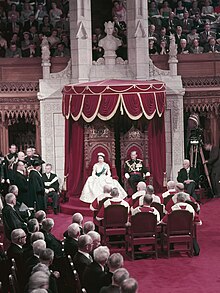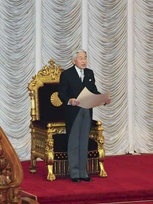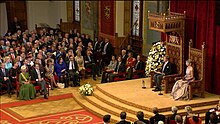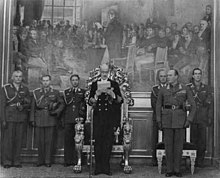
A speech from the throne, or throne speech, is an event in certain monarchies in which the reigning sovereign, or their representative, reads a prepared speech to members of the nation's legislature when a session is opened. The address sets forth the government's priorities for its legislative agenda, for which the cooperation of the legislature is sought. The speech is often accompanied by formal ceremony. It is often held annually, although in some places it may occur more or less frequently, whenever a new session of the legislature is opened.
Historically, when monarchs exercised personal influence and overall decision-making in government, a speech from the throne would outline the policies and objectives of the monarch; the speech was usually prepared by the monarch's advisers, but the monarch supervised the drafting of the speech at least to some extent and exercised final discretion as to its content. In modern constitutional monarchies, whether by law or by convention, the head of state or their representative reads the speech from the throne, but it is prepared by the ministers in cabinet.
Of contemporary European monarchies today, this traditional event is held in the United Kingdom, where it is also known as the King's Speech (or Queen's Speech if the reigning monarch is female); the Netherlands, on Prince's Day; and Norway. In other countries the monarch may or may not attend the opening of the country's legislature; they may also give a speech, but these speeches, in contrast, do not outline any government agenda.
Many republics have adopted a similar practice in which the head of state, often a president, addresses the legislature; in the United States, the president makes an annual State of the Union address, in the Philippines the president makes an annual State of the Nation Address. In parliamentary republics where the president is merely a ceremonial figurehead, these speeches are often similar in tone to the throne speech of a constitutional monarchy, whereas in presidential systems such as the U.S. the speeches are somewhat different in that the president exercises personal discretion over the content but the principle of separation of powers means the legislature is not obligated to follow whatever agenda (if any) may be contained in such a speech.
Commonwealth realms

Terminology
In the United Kingdom, the speech is known as His Majesty's Most Gracious Speech, the Gracious Address, or, less formally, the King's Speech (or Queen's Speech, when the reigning monarch is female). In Canada, it is known as the Speech from the Throne (often shortened to Throne Speech) (in French: Discours du Trône). Since 1973, the lieutenant governor of Quebec has delivered a short inaugural address termed the Allocution, after which the premier reads his or her Discours d'ouverture (Opening Speech), called the Message inaugural from 1974 to 1984.
In Hong Kong, the governor's address was termed the Policy Address during Chris Patten's governorship. In the Irish Free State, the governor-general delivered the Governor-General's Address to Dáil Éireann; only two were ever given, in 1922 and 1923.
History
In the Commonwealth realms, the speech from the throne is an oration that forms part of a ceremony marking the opening of parliament. Some records indicate the ceremony has taken place since the Middle Ages, while others place its origins in the 16th century, when England was still an absolute monarchy. The speech explained to parliament the reasons it was summoned and sometimes set out the sovereign's policies and objectives. The monarch would sometimes speak to parliament in person; Edward III (in 1365), Richard II, and Edward IV did so to both houses of parliament on multiple separate occasions.
However, various other figures gave the oration on the sovereign's behalf: between 1347 and 1363, it was read by the chief justice; in 1401 by the chief justice of the Common Pleas; in 1344, 1368, 1377 (speaking for a presiding Edward III), 1399, and 1422, by the archbishop of Canterbury; and in 1343, 1363, and, usually after 1368, by the lord chancellor who was then the prolocutor, or chairman of the House of Lords. It was given on his behalf by the bishop of Winchester in 1410; in 1453 and 1467, the bishop of Lincoln; the bishop of Rochester in 1472; and the keeper of the Privy Seal in 1431. It may have been written by or with the input of the king's or queen's advisers, but, the monarch, as supreme governor, was the principal author.
Modern times
Today, within the tenets of constitutional monarchy, the speech is written by the sitting cabinet, with or without the reader's participation, and outlines the legislative programme for the new parliamentary session. Due to the parliamentary tradition of the sovereign being barred from the lower chamber, in those realms possessing a bicameral parliament, the ceremony takes place in the legislature's upper chamber, with members of both houses in attendance. In unicameral parliaments, the speech is read in the one legislative chamber. Unusually, in the Irish Free State, the speech was delivered in the lower house of its bicameral parliament.

In the United Kingdom, the speech is typically read by the reigning sovereign at the State Opening of Parliament. Traditions surrounding the opening and the speech go back to the 16th century; the present ceremony dates from 1852, when the Palace of Westminster was rebuilt after the 1834 fire. The ceremony now usually occurs annually, usually in November or December, or soon after a general election. The monarch may, however, appoint a delegate to perform the task in his or her place. Elizabeth II did this during her pregnancies in 1959 and 1963, delivered instead by Lord Chancellor; and again due to ill health in 2022, delivered instead by Prince Charles (now Charles III) who, along with Prince William, were acting as Counsellors of State.

In those countries that share with the UK the same person as their respective sovereign, the speech from the throne will usually be read on the monarch's behalf by his or her viceroy, the governor-general, although the monarch may deliver the address in person: Queen Elizabeth II read the Throne Speech in the Parliament of New Zealand in 1954, 1963, 1970, 1974, 1977, 1986, and 1990, the Parliament of Australia in 1954 and 1974, and the Parliament of Canada in 1957 and 1977. Another member of the royal family may also perform this duty, such as when, on 1 September 1919, the Prince of Wales (later King Edward VIII) read the Speech From the Throne in the Canadian parliament. On two occasions, the administrator of the Government delivered the address to the Parliament of Canada: 16 May 1963 and 30 September 1974.
In the Australian states, the relevant governor reads the speech, though the Australian monarch may also perform the task: Queen Elizabeth II opened the parliaments of some of the Australian states in 1954 and of New South Wales in 1992. In almost all the Canadian provinces, the relevant lieutenant governor delivers the speech; it is uncertain whether the Canadian monarch can do the same in any legislature of a Canadian province. In Quebec, however, the speech is referred to as the "Opening Address" (French: Allocution d'ouverture). In each of the Canadian territories, the commissioner reads the Throne Speech or Opening Address to the legislature.
In British overseas territories that have instituted this practice, the relevant governor delivers the speech. A throne speech is not typical in the devolved legislatures within the United Kingdom; the nearest equivalent is a statement of the legislative agenda of the executive branch, usually given by a first minister. However, the British monarch often undertakes visits and speaks to the devolved bodies in a less official capacity. During her reign Queen Elizabeth II was present and gave an address at all openings of the Scottish parliament, usually speaking reflectively upon its accomplishments and wishing the institution well for its coming term rather than considering the plans of the executive.
It is considered improper for the audience, including members of parliament, to show support or disapproval for any content of the speech while it is being read: that is reserved to the debate and vote that follows in legislative chambers or chamber. In 1998 in the UK, when the Queen read out the proposed House of Lords Act 1999, Labour Party MPs briefly interrupted it by vocalising support while Conservative peers responded with "shame!". Protest, though, has been expressed during a throne speech, such as when, in 2011, Brigette DePape, a page in the Canadian Senate, interrupted Governor General David Johnston's reading of the Speech From the Throne by standing and holding a sign calling for the then Prime Minister, Stephen Harper, to be stopped.
Address in reply
Formally, the motion that follows the speech merely calls on parliament to thank the monarch or viceroy via an Address in Reply. The debate is, however, often wide-ranging, exploring many aspects of the government's proposed policies, and spread over several days. When the Address in Reply is eventually voted on, the poll is held to constitute a motion of confidence in the government, which, if lost, would result in the end of that government's mandate. In some legislatures, this discussion and vote is preceded by a symbolic raising of other matters, designed to highlight the independence of parliament from the Crown; a practice that originated after King Charles I was tried and executed by parliament. In the British House of Commons, the other business raised is by tradition the Outlawries Bill, while the House of Lords reads the Select Vestries Bill; neither proceeds past the first reading. In the House of Commons of Canada, the bill considered is Bill C-1, an Act Respecting the Administration of Oaths of Office, while in the Senate, it is Bill S-1, an Act Relating to Railways. The texts of these two bills have nothing to do with either oaths of office or railways; instead, they contain near-identical wordings that explain their pro forma function. In Australia and New Zealand, by contrast, no pro forma bills are introduced; there, the respective houses of representatives instead consider some brief and non-controversial business items before debating the Address in Reply.
Other countries
Japan

In Japan, the emperor makes only a short speech of greeting during the National Diet opening ceremony; he does not refer to any government policies, instead allowing the Prime Minister to address political matters, as in the contemporary cases in Sweden and Denmark.
Malaysia
Malaysia also has the same practice, with the Yang di-Pertuan Agong making such an address to the Parliament of Malaysia in joint session during its state opening yearly every March.
Morocco
In accordance with the constitution, the king addresses parliament at the beginning of its yearly session on the second Friday of October. The speech may only be made legally binding if it is read before both houses of parliament. Additionally, the monarch addresses the nation on the anniversaries of his accession (Throne Day), the Revolution of the King and the People and the Green March.
Netherlands

In the Netherlands, the speech from the throne is held annually on the third Tuesday in September, which is called Prinsjesdag (Prince's Day). Article 65 of the constitution states that "A statement of the policy to be pursued by the Government is given by or on behalf of the King before a joint session of the two Houses of the States General that is held every year on the third Tuesday in September or on such earlier date as may be prescribed by Act of Parliament."
The monarch travels from Noordeinde Palace by coach to the Ridderzaal (Hall of Knights) in the Binnenhof of The Hague to read the speech before a joint session of the States General. Following the speech, the president of the joint session calls out 'Long live the King!’ after which the monarch is greeted with three cheers. The monarch and his retinue leave and the joint session is declared to be closed. The monarch returns to the palace in the coach and, along with other members of the royal house, appears on the palace balcony. Following the 1983 revision of the constitution, a parliamentary session changed from lasting a year to lasting for four years. As a result, the speech no longer marks the opening of a session of parliament but the start of a new parliamentary year.
Norway

In Norway, the monarch is required by article 74 of the constitution to preside over the opening of a session of the Storting (which happens every October) after it has been declared to be legally constituted by the president of the Storting. The monarch delivers the speech before parliamentarians in the chamber of the Storting. The heir to the throne also regularly accompanies the monarch.
Upon the monarch's arrival in the chamber, the members of the Storting stand and the first verse of the royal anthem, Kongesangen, is sung. The monarch is handed the speech by the prime minister and proceeds to deliver the speech while all remain standing. Afterwards, the monarch and members take their seats and the Report on the State of the Realm, an account of the government achievement of the past year, is read (traditionally in Nynorsk), customarily by the youngest member of the government present.
The members and monarch rise and the monarch is presented with the report by the prime minister and the monarch returns the speech and report to the president. The president gives some remarks and closes with "May God preserve our King and country", joined by other members of the Storting and the first verse of the national anthem is then sung. After the monarch and his retinue have left, the meeting is adjourned and the speech and report are first debated at the subsequent sitting.
Spain
In Spain, speeches from the throne used to be practiced before the declaration of the Second Spanish Republic in 1931. With the restoration of the Spanish monarchy in 1975, the monarch still opens parliament but no longer gives a "speech from the throne". The monarch gives a speech but it does not focus on or direct government policy.
Sweden

In Sweden, the practice of having a speech from the throne given by the monarch was held until 1974, coinciding with the rewrite of the constitution of Sweden which removed formal involvement of the monarch in the legislative process. The old opening of the legislature was called "The Solemn Opening of the Riksdag" (Swedish: Riksdagens högtidliga öppnande) and was full of symbolism. The speech was given before the Riksdag in the Hall of State at the Royal Palace. The King would be seated on the Silver Throne as he gave his speech.
Prior to 1907, the monarch and the princes of the royal blood would also wear their royal and princely robes and their crowns and coronets. After Oscar II's death, his successor, Gustav V was not crowned, and thus did not wear the crown when opening the Riksdag. Instead, the crown and sceptre would be placed on cushions beside the throne and the robe would be draped on the throne.
After the abolition of the opening ceremony at the palace, last held in 1974 and only once during the reign of Carl XVI Gustaf, the opening is now held at the Riksdag chamber in the presence of the monarch and his family. It is still the monarch who officially opens the annual session but he no longer gives a "speech from the throne"; the monarch is invited by the Speaker and delivers an introductory speech and then declares the session open. After the speech, the Prime Minister delivers a statement of the upcoming government agenda (Swedish: Regeringsförklaring) for the forthcoming legislative year is made.
Thailand
In Thailand, the monarch makes a speech at a joint session in the Ananta Samakhom Throne Hall, advising the National Assembly in their work.
Republics
Many republics also hold a yearly event in which the president gives a speech to a joint session of the legislature, such as the State of the Union address given by the president of the United States and in most U.S. states, where the governor gives a similar State of the State address. Similarly, the president of the Philippines gives the State of the Nation Address. Often such are on or near the first day of the legislature's new session. However, in theory, rather than just outline the priorities for the coming year, the head of state is supposed to provide a report to the legislature on what the country's condition is, hence the term State of the Nation.
Historical speeches
-
 Emperor Alexander II of Russia reconvening the Diet of Finland in 1863
Emperor Alexander II of Russia reconvening the Diet of Finland in 1863
-
 Emperor Pedro II of Brazil delivering the speech from the throne wearing the Imperial Regalia, 1872
Emperor Pedro II of Brazil delivering the speech from the throne wearing the Imperial Regalia, 1872
-
 German emperor Wilhelm II opening the Reichstag in the White Hall of the Berlin Palace, 1888. Painted by Anton von Werner
German emperor Wilhelm II opening the Reichstag in the White Hall of the Berlin Palace, 1888. Painted by Anton von Werner
-
 Emperor Haile Selassie I giving the speech from the throne in front of parliament
Emperor Haile Selassie I giving the speech from the throne in front of parliament
See also
- Opening of the Canadian parliament
- State of the Nation (disambiguation)
- National Day Rally
- Royal Christmas Message
References
- "The King's Speech 2023". GOV.UK. 7 November 2023. Retrieved 6 December 2023.
- admin (21 April 2011). "From Prince's Day to Accountability Day". houseofrepresentatives.nl. Retrieved 10 January 2023.
- ^ "What is the Queen's Speech?". BBC. 3 December 2008. Retrieved 14 August 2008.
- ^ Woods, Henrik (2011), "My Lords and Gentlemen": A Study of British Origins and the Evolution of the Canadian Throne Speech Genre (PDF), Library and Archives Canada, p. 5, retrieved 30 September 2015
- "What You Need to Know About the Queen's Speech". Sky News. 27 May 2015. Retrieved 20 September 2015.
- Bright, James Franck (1885). A History of England: Period II. Personal monarchy: Henry VII. to James II. 1485–1688. Princeton University: Dutton. p. 594. Retrieved 2 November 2015.
- ^ Jennings, George Henry (1881). An Anecdotal History of the British Parliament: From the Earliest Periods to the Present Time. With Notices of Eminent Parliamentary Men, and Examples of Their Oratory. D. Appleton. p. 429. Retrieved 30 September 2015.
- ^ Jennings 1881, p. 430
- ^ Government of Canada. "Speech From the Throne". Queen's Printer for Canada. Archived from the original on 19 October 2013. Retrieved 20 September 2015.
- House of Lords Library (9 November 2007). "Parliament Home Page > Frequently Asked Questions > State Opening". Queen's Printer. Archived from the original on 2 May 2009. Retrieved 2 December 2009.
- Chisholm, Hugh, ed. (1911). "Black Rod" . Encyclopædia Britannica. Vol. 4 (11th ed.). Cambridge University Press.
- Library of Parliament. "Opening of a Parliament and a Session". House of Commons Procedure and Practice (2 ed.). Queen's Printer for Canada. Retrieved 19 September 2015.
- Parliament of the United Kingdom. "About Parliament > How Parliament works > Parliamentary occasions > State Opening of Parliament". Queen's Printer. Retrieved 13 September 2010.
- "Prince Charles to deliver Queen's Speech for first time". BBC News. 10 May 2022.
- National Museum of Australia. "Exhibitions > Past exhibitions > Royal Romance > Crowns and gowns". Queen's Printer for Australia. Retrieved 2 December 2009.
- Senate of Canada (June 2015), Senate Procedure and Practice (PDF), Ottawa: Queen's Printer for Canada, p. 42, retrieved 15 November 2015
- "Allocution d'ouverture". Journal des débats. 44 (2). National Assembly of Quebec: 15–16. 21 May 2014.
- "McLeish unveils legislative plans". BBC. 5 September 2009. Retrieved 19 November 2009.
- Senate of Canada 2015, p. 43
- "1998: Queen's speech spells end for peers". 24 November 1998.
- "Page with 'Stop Harper' sign fired from Senate". CTV News. 3 June 2011. Archived from the original on 6 June 2011. Retrieved 5 June 2011.
- House of Commons Library (September 2008), "Parliamentary Elections" (PDF), Factsheet M7, Queen's Printer, p. 3, ISSN 0144-4689, archived from the original (PDF) on 25 March 2009, retrieved 19 November 2009
- Woods 2011, p. 6
- ^ "39th Parliament, 2nd Session". Hansard (1). Ottawa: Queen's Printer for Canada. 16 October 2007. 2000. Retrieved 2 December 2009.
- ^ "Debates of the Senate, 2nd Session, 39th Parliament". Hansard. 144 (1). Ottawa: Queen's Printer for Canada. 16 October 2007. Retrieved 2 December 2009.
- "The Parliament of the Commonwealth of Australia, House of Representatives Votes and Proceedings" (PDF). Hansard (1). Canberra: Queen's Printer for Australia. 12 February 2008. Retrieved 2 December 2009.
- "Daily debates". Hansard. 651. Wellington: Queen's Printer: 7. 9 December 2008. Retrieved 2 December 2009.
- McLaren, Walter Wallace (2007). A Political History of Japan During the Meiji Era, 1867-1912. Read Books. p. 361. ISBN 978-1-4067-4539-9.
- "Morocco 2011 Constitution". Constitute Project. Retrieved 30 July 2024.
- "His Majesty the King Delivers Speech at Parliament Opening". Ministry of Foreign Affairs, African Cooperation and Moroccan Expatriates. Retrieved 30 July 2024.
- Gabriel, Edward M. (30 July 2018). "King Mohammed VI, Then and Now". Morocco On The Move. Retrieved 30 July 2024.
- "His Majesty the King Delivers Speech to Nation on 46th Anniversary of Green March". Ministry of Foreign Affairs, African Cooperation and Moroccan Expatriates. Retrieved 30 July 2024.
- "Prinsjesdag". Dutch Royal House. 6 February 2015. Retrieved 23 June 2017.
- "Route of the Golden Coach". Dutch Royal House. Retrieved 23 June 2017.
- "Joint session". Dutch Royal House. 6 February 2015. Retrieved 23 June 2017.
- "Origins and history". Dutch Royal House. 6 February 2015. Retrieved 4 July 2017.
- "Opening of the Storting". Norwegian Royal Court. Retrieved 23 June 2017.
- ^ "The formal State Opening of the Storting". Stortinget. 2 September 2016. Retrieved 23 June 2017.
- ^ "The State Opening of the Storting". Stortinget. 1 October 2015. Retrieved 7 July 2017.
- "Parliament opens with full formality". newsinenglish.no. 3 October 2016. Retrieved 7 July 2017.
- Riksdag. "Programme for the opening of the 2007/08 Riksdag session". Hedman, Karin. Retrieved 3 December 2009.
External links
Canada
- Speech from the Throne
- Parliament of Canada records of past Speeches from the Throne and Motions for Address in Reply
United Kingdom
- Queen's Speech in the UK Parliament 2021 – GOV.UK
- Queen's Speech in the UK Parliament December 2019 – GOV.UK
- Queen's Speech in the UK Parliament October 2019 – GOV.UK
- Queen's Speech in the UK Parliament 2017 – GOV.UK
- Queen's Speech in the UK Parliament 2016 – GOV.UK
- All speeches in Parliament by the Queen – They Work For You
| Monarchy in Canada | |
|---|---|
| The Crown | |
| Monarchs | |
| Viceroys | |
| Constitutional | |
| Legal | |
| Ceremonial and symbolic | |
| Related | |
| Parliament of Australia | |||||
|---|---|---|---|---|---|
| Components |
|  | |||
| Parliamentary officers |
| ||||
| Members |
| ||||
| Parliaments | |||||
| Procedure | |||||
| Elections |
| ||||
| Locations | |||||
| See also | |||||
| Parliament of New Zealand | |||||
|---|---|---|---|---|---|
| Components |
|   | |||
| Parliamentary officers |
| ||||
| Members |
| ||||
| Procedure | |||||
| Elections |
| ||||
| Locations |
| ||||
| Miscellaneous | |||||